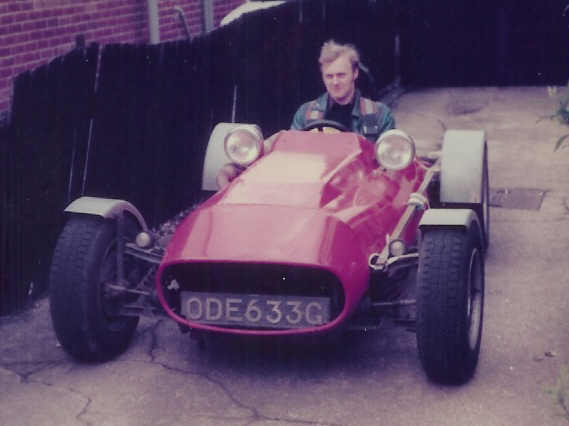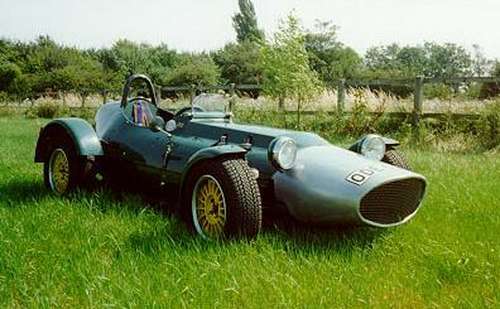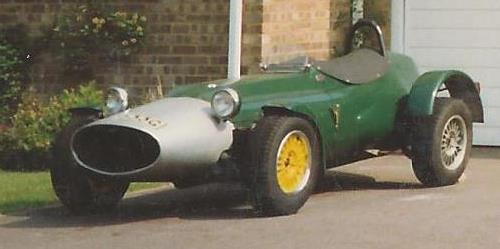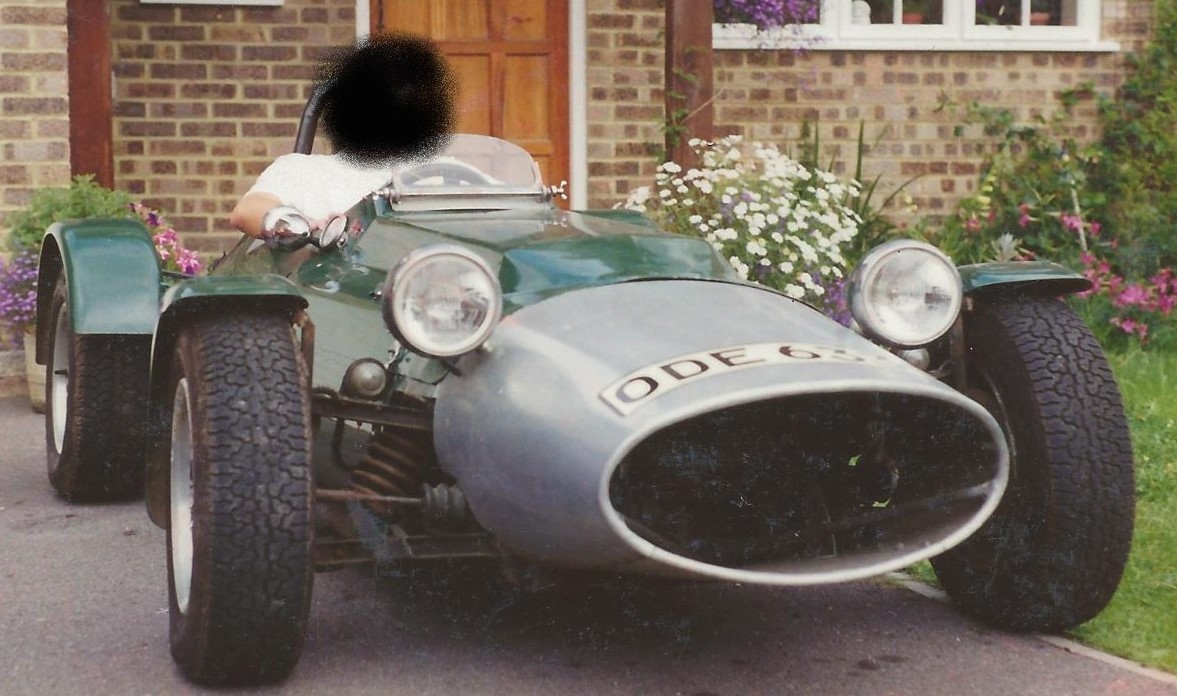ODE 633G (The Bomb)

Compiled/abridged by DC from Pitstop articles
As noted elsewhere this car was one of Paul Moorhouse’s specials, “The Bomb” being a name given to it by James Doherty.
The running gear is based on Triumph Vitesse Mk 2, with the Roto-flex couplings and a seriously reduced transverse leaf spring. Front suspension is stock Triumph with cut down Vitesse spring. The car has a single seat astride the prop shaft! There is a large plate under the seat! The engine is in the front with rear wheel drive.
The seat is behind the engine/ gearbox.
The Chassis is constructed from some heavy box section steel with mostly aluminium bodywork. The shape of the car is derived from an early ’60’s Fl racer and is now in the Lotus colours of British racing green and yellow wheels, although originally it was finished in Red. The small custom-made fuel tank is located behind the driver. The exhaust runs down the side of the car, a straight through system with the centre section apparently being a Triumph prop shaft.
Charles Lancaster says:
The car is known to all early Triumph Marlin builders, as it used to sit under a tarpaulin at his house in Plymouth and was obviously a topic of conversation when one went to look at the Marlin prototype. From there it was moved to his barn in Yelverton, where it lay dormant for some years as Paul busied himself with the commercial success that is Marlin Engineering. I believe the car was involved in some sort of accident, but any way, it was then adorned with a new nose cone, but no mudguards or bonnet. It was in this state that it was bought by James Doherty, to use as a donor car for a Marlin, no less. James then reconsidered, cancelled his order for a Marlin, and proceeded to paint the car green, construct a bonnet and mudguards and fit headlamps.
Originally the headlamps were fitted amidships, in line with the steering wheel, no doubt so that the driver could adjust them while underway. They are now in a more conventional location, in line with the side lamps! James then acquired a girlfriend (now wife) whose legs were too long to allow her to sit on his lap, as I believe Paul used to do (with Gill?), and a gearbox failure encouraged him to sell it to me. I bought it for spares primarily for my Marlin and Triumph Vitesse Mk 2 and robbed it of its 2.5 litre engine and overdrive gearbox, substituting the Mk1 2 litre lump from my Marlin. I had the wheels polished and painted Lotus Yellow, and did a bit of tidying up of wiring and pipework, but failed to put it back on the road.
Ben Shaughnessy bought the car from me in the Spring of 1996, and then Ben and David Stoddart worked on it. Ben initially got the car running and passed an MOT from his garden. We came to an agreement that the car could live in David’s garage and they would share the running and building of the car. The first major problem was to sort out the brakes, which were hopeless. The discs were not in a very good state, pitted and quite rusty. A new set of front discs and Mintex fast road pads were fitted, costing about £50. New rear shoes were also fitted. At the same time the master cylinder was changed from a 3/8″ from 5/8”. The car now had much better brakes. These were then improved by fitting Aeroquip hoses. The brakes are now fantastic. The Aeroquip hoses are very good and worth considering on any car. The rear suspension was on the soft side and far too low. There is no way you would be able to get out the local Tesco’s car park with its speed hump. A unit based on a Triumph racing part replaced the old spring. This raised the rear of the car and stiffened the rear allowing the shock absorbers to work. The major remaining problems were the electrical system, which was getting old and unreliable, the engine overheated as soon as the car came to a halt and the car would not always start. The old bullet connectors were quite badly corroded. The car was rewired after the local police had stopped Ben because the rear lights had failed. Thankfully the nice WPC followed him home rather than ‘do’ him after being allowed to sit in the car. Since then, the only electrical problem is the dynamo not charging at low engine speeds, and the new cooling fan draws a lot of current.
The next area to get treatment was the cooling. The original radiator was from a Ford Anglia. When we bought the Bomb, it had a 2litre 6-cylinder Mk 1 Triumph Vitesse lump in it. The originally fitted 2.5 Litre engine having been stolen by the previous owner (Charles Lancaster!) to fit in a certain Marlin at the time. The radiator and fan just could just not cope. The solution was to fit a custom radiator that was built by a local radiator company, who did a superb job. The core came from a Land Rover and the rest was made from templates made by us. The new cooling fan came from a Vauxhall Cavalier and the fan housing from a Ford Escort. These were mounted on the front of the radiator in the nosecone, blowing back into the engine bay. Having spent so much getting the new radiator fitted, a grill was welded into place at the front of the car to protect it from flying stones and wildlife. The radiator has a small valve on the top to ensure it is fully filled, and it has solved most of the overheating problems.
The other problem we had was with the expansion tank. This used to be below the top of the engine and very hard to fill up. We found out about this problem going down the motorway to the Stoneleigh kit car show. The volume of water in the new radiator was too much for the capacity of the expansion tank. The expansion of the water from 20°C to 90°C was more than the volume of the expansion tank. After about 30 minutes on the motorway the engine overheated in a big way. I had to pull to the side in a big cloud of steam. It apparently looked quiet spectacular from the Marlin behind. The engine was dry. Thankfully we were close to some motorway services where we were able to fill up with water and retreat back home. The solution to this was to build a bigger custom welded aluminium expansion tank, which was mounted beside the rocker cover, similar to that on a GT6. This has worked really well allowing the system to be fully filled with water and to have sufficient room to expand as the engine heats up. It could probably do with a heat shield underneath to stop heat-soak from the exhaust manifold. The ancient (Morris Minor) SU fuel pumps also gave us random problems with starting and running. This was replaced with a new Facet unit and all starting problems have gone. The fuel pump has the capacity to handle an engine of up to 200 BHP, which should prove useful with the tuned 2-Litre lump now fitted.
The major overheating caused a few problems, the head gasket went and the engine felt a little down on power. We then acquired a 2 Litre unit, which has been completely rebuilt using new bearings, pistons, rods, bigger valves, camshaft and the head flowed. A rally Piper camshaft was fitted and the compression raised slightly. The head was modified to take unleaded fuel at the same time. The engine is now in the car and awaiting carburettors.
We had a problem with the starter. The starter from the 2litre engine would not even turn the new motor over. We now have a larger starter motor fitted, which has the desired effect. We will be using a pair of SU carburettors rather than the Strombergs originally fitted. Hopefully the new engine will be fired up and running soon.
Other changes for the near future will include the much awaited new bonnet/engine cover. The old one has been looking rough for a while. We had to cut a hole in the front of the cover to allow the dynamo to be raised and take it away from the oil cooler return pipes. This was done after a small, but worrying problem caused by the oil pipe rubbing against the dynamo drive belt. This sprayed oil everywhere causing us to think a major engine failure had occurred. With the newer engine the rear tyres will need upgrading to something softer, to save the differential. New seat belts and hopefully a new adjustable seat will be fitted soon. At the moment you have to be about 6 foot tall to drive, otherwise you won’t be able to reach the pedals. The roll bar will also have to be moved upwards, it’s just too low for anybody 6 foot tall. At some point the fuel tank will need to be replaced, hopefully with a foam filled race tank to make things a bit safer. The exhaust will also be replaced at some stage. This will have to be a custom unit, which we will have made from Stainless Steel. An alternator will at some stage replace the older dynamo. Something will also have to be done about the heat in the cockpit. The heat from the engine in front and the exhaust that runs down the side of the car is overpowering on a hot day. Hopefully we should make it to some of the kit car shows and race meetings in 1999 and should be seen on the road a bit more. I would love to take the car to Le Mans one year, where it should create a stir.

Pic copyright unknown
Owning and driving The Bomb is an absolutely unique experience in every way. Getting in involves gymnastic feats (and also gymnastic feet) to balance your body weight on the rolled aluminium sides as you thread your legs either side of the gear box, ensuring that the gear lever doesn’t go up your left trouser leg. Once in the vehicle, you feel like you’re in a Formula Ford racer or the like, as you’re sandwiched between Moorhousian one inch square steel tubing, semi-recumbent. Feet cannot help but find the pedals, there is nowhere else for them to go! Seating position is comfortable with arms resting on the outside of the bodywork. Insert the key, lift the ignition cut out latch switch and press the red button. The sound of the throbbing 6 cylinder engine as it rattles its way down the straight through unbaffled exhaust is absolutely fabulous and slightly reminiscent of the old Bentleys with their now outlawed copper exhausts. There’s a slight rattle of pushrods on the cold engine, and the hiss of the carburettors doing their business. Donning the obligatory goggles and leather helmet, you are ready to go. Selecting gears is the first challenge.
The 4 inch long gear lever is mounted on the right hand side of the “fuselage”, and is connected via rose joints to a tube that runs under your left leg to the gearbox. There is no “gate”, and initial gear selection is somewhat hit and miss. First (on the Triumph box) is between third and reverse, and you quickly know when you have the wrong one! It’s worth being a little cautious as you first lift your foot, and save the embarrassment of burying the car in the radiator of the one behind, or less serious, stalling it. Indeed, finding first is something of an acquired knack. There is also an irritating little “lift the dot stud” poking through the body which somehow also manages to catch you on your knuckle right on the bony bit.
Once underway, progress is smooth and fast and not a little raucous, the straight through exhaust emitting a cacophony of rasping sounds as you hunt your way through the gears. The car sits back on the slightly soft rear spring under acceleration. Initially the sight of the front wheels turning and bumping up and down way ahead of you is slightly peculiar, as are the two frogeye headlamps. The ride is firm but not hard, and cornering is entertaining and involving! Protection afforded by the Aero Screen wind deflector is absolutely minimal, and you quickly come to appreciate the need for the goggles, and keeping your mouth shut. At high speed, the wind pressure on your face is quite considerable and if you turn your head it takes quite some effort to straighten up again to look straight ahead. Getting caught in the rain is another good time to use the goggles and keep your mouth shut, particularly as you go through unavoidable puddles. The experience can be compared to helming a small boat on a tight tack across the Solent. All the spray from the front wheels comes around the cycle type mudguards in a wide arc to hit you full in the face.
When you stop, however, you will never be alone, from old buffers saying “I remember Stirling Moss driving one of them at Donnington in 1960 something”, to young kids with eyes alight saying, “Mum, Mum, can I have one of them”.
All in all a fabulous piece of machinery, and many thanks to Paul for giving so many people so much fun with his robust and beautiful engineering.

C Lancaster pic

C Lancaster pic.
+ + +
OK so that was all in 1999 and earlier. The DVLA site currently says that the vehicle is a Green Triumph, on a SORN, last V5 issued in 2012
What do we know of the car today, and is it likely to re appear any time soon ? DC March 2021
